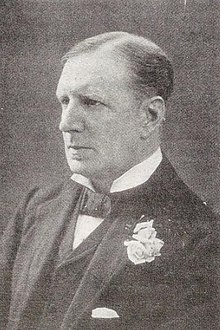Arthur Havelock
Sir Arthur Havelock Gerald Strickland | |
|---|---|
| 4th Administrator of Saint Lucia | |
| In office December 1878 – December 1879 | |
| Monarch | Victoria |
| Preceded by | William Des Vœux |
| Succeeded by | Sir Roger Goldsworth |
| Personal details | |
| Born | 7 May 1844 Bath, Somerset, England |
| Died | 25 June 1908 (aged 64) Bath, Somerset, England |
| Spouse | Anne Grace Norris |
| Relations | Sir Henry Havelock (uncle) |
| Alma mater | Royal Military College, Sandhurst |
Sir Arthur Elibank Havelock,
Early life and family
Havelock was born in 1844 in
Military career
In 1860, Havelock entered the
Havelock held several key posts in the colonial civil service from 1874: chief
Colonial service
Havelock joined the colonial civil service upon leaving the army, and was sent to the
Governor of Sierra Leone
In February 1881, Havelock was assigned his first governorship in Sierra Leone and the West African settlements. In addition, he was appointed British consul to Liberia, and became involved in a major border dispute between Liberia and Great Britain. The border between Sierra Leone and Liberia had been unsettled for years, the disputed area – lying between the Sewa and the Mano rivers – known as the Gallinas territory. On 20 March 1882, Havelock led a flotilla of four British gunboats to the Liberian capital Monrovia, issuing a demand that Liberia cede all territories up to the Mafa River, and pay an indemnity of £8,500 to British merchants for injuries inflicted by tribes inhabiting the area of the British claim. A treaty was signed, but its ratification was refused by the Liberian Senate, and Havelock and his gunboats returned to Monrovia in September that year, demanding immediate acknowledgement of the British claims, and ratification of the treaty.[1]
The senate refused once more, and the British quietly occupied the claimed territory in March 1883. Despite the support of the United States, Liberia realised that resisting the British claim was futile, and signed the treaty in London on 22 November 1885.[2] The border was finally settled in 1903 by a mixed commission from both countries.[1]
Governor of Trinidad
In 1885, Havelock was appointed
Governor of Natal
In 1886, Havelock became
Governor of Ceylon

In March 1890, Havelock was appointed Governor of Ceylon (now Sri Lanka),[3] where his actions included extending the country's railways to Kurunegala and Bandarawela, and abolishing the 'paddy tax', a levy on rice cultivation.[4] He was also held in great esteem among the aristocracy of Sri Lanka, with two prominent families appointing him Godfather to the heirs. One such godson was the grandson of Muadliya Solomnon Carolis de Fonseka while the other was the son of Solomon Dias Bandaranaike. The de Fonseka family named their estate Havelock from its original name Katukele Greenlands, along with various parts of their large estate (now Havelocktown) after Havelock, these include Elibank road and Havelock Pass (now forming the bridge).[citation needed]
Governor of Madras
Havelock returned to his childhood home of India as
Governor of Tasmania
Havelock left Madras in 1901, and was offered the governorships of the
Later life
Havelock returned to England, and retired to Torquay, Devon.[8]
On 15 August 1871, Havelock had married Anne Grace, née Norris, who died in early 1908. Havelock himself died at Bath, Somerset less than six months later on 25 June 1908. He was survived by a daughter.[7]
Honours
- CMG: Companion of the Order of St Michael and St George1880
- KCMG: Knight Commander of the Order of St Michael and St George1884
- GCMG: Knight Grand Cross of the Order of St Michael and St George1895
- GCIE: Knight Grand Commander of the Order of the Indian Empire 16 March 1896 – on appointment as Governor of Madras[9]
- GCSI: Knight Grand Commander of the Order of the Star of India 29 April 1901 – for his services as Governor of Madras[10]
References
- ^ Oxford Dictionary of National Biography, Oxford University Press, 2004; online edn, Oct 2005, accessed 21 April 2008.
- ISBN 0-521-33571-X.
- ^ London Gazette issue 26033, 14 March 1890[dead link]
- ^ Michael W. Roberts: Grain Taxes in British Ceylon, 1832–1878: Problems in the Field, The Journal of Asian Studies, Vol. 27, No. 4 (Aug., 1968), pp. 809–834.
- ^ "No. 27318". The London Gazette. 28 May 1901. p. 3633.
- ^ "Tasmania". The Times. No. 36608. London. 9 November 1901. p. 8.
- ^ a b George B. Cartland, Havelock, Sir Arthur Elibank (1844–1908), Australian Dictionary of Biography, Volume 9, Melbourne University Press, 1983, pp 228–229.
- ^ Woods, Gabriel Stanley (1912). . In Lee, Sidney (ed.). Dictionary of National Biography (2nd supplement). London: Smith, Elder & Co.
- ^ "No. 26722". The London Gazette. 17 March 1896. p. 1744.
- ^ "No. 27309". The London Gazette. 30 April 1901. p. 2945.
- ^ Khan, Mukram (21 March 2009). "The Havelock Bridge Memorial Stone". Flickr. Retrieved 30 July 2012.

